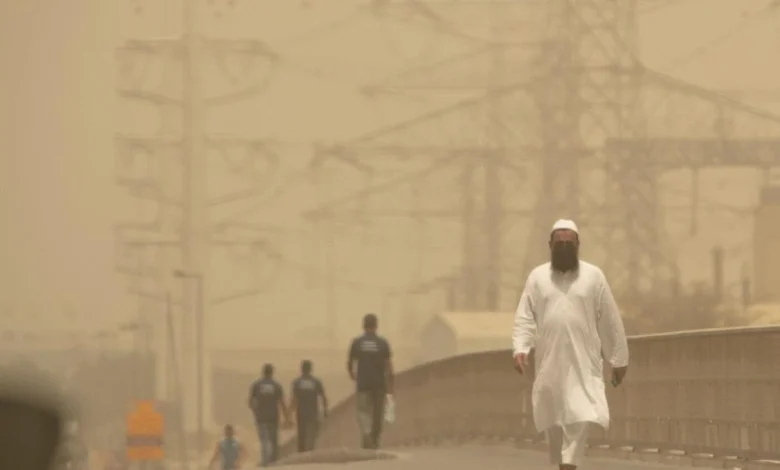
When Nature Struck: UAE’s Devastating 48-Hour Sandstorm Flashback
A powerful sandstorm swept through the UAE, reducing visibility to just 500 meters as fierce desert winds battered the nation. The event from 19 years ago created hazardous conditions that left motorists stranded and forced flights to divert, bringing the country to a standstill.
The severe weather event began shortly after 1pm on July 6, 2005, with strong winds that reached speeds over 20 knots (37kmph). The storm’s impact was widespread – Abu Dhabi experienced a major traffic accident, while Dubai International Airport’s flights had to be diverted. This left many passengers stuck at various locations. The storm’s fury extended to the seas, where waves surged to heights exceeding 8 feet offshore and 4 feet along the coast. Maritime authorities quickly issued warnings to protect vessels. The intense weather system did bring one unexpected benefit – Sharjah International Airport’s maximum temperature dropped to 36°C.
Sandstorm Engulfs UAE for 48 Hours
Image Source: Gulf News
“Such dust storms are not uncommon in the UAE during the summer months, when dry conditions and gusty winds can sweep sand and dust across large areas.” — National Center of Meteorology (NCM), UAE government meteorological authority
A giant wall of dust swept over the United Arab Emirates when northwesterly winds blew at speeds of 40 kilometers per hour across the region. This powerful system came from Iraq’s Tigris-Euphrates basin and Saudi Arabia’s Empty Quarter. The storm turned into one of the worst dust events to strike the peninsula in years.
The 48-hour assault sent PM10 concentrations to dangerous levels that went beyond 1000 μg/m3 across most of the UAE. Readings along the western coast climbed past 1500 μg/m3 and this hit major cities like Abu Dhabi and Dubai hard. These numbers are a big deal as they mean that the air quality was well into the “unhealthy” range, which starts at 352.
The National Center of Meteorology raised alerts as thick orange haze cut visibility to less than 2000 meters in coastal and internal areas. Drivers saw electronic signs on highways that asked them to slow down as the sandstorm continued into its second day.
Meteorologists noted that this matched typical patterns of extreme dust storms in the region. These events happen regularly but climate change makes them more common by intensifying weather patterns. Low-level winds that wouldn’t go away met areas where soil erodes easily. This encouraged more dust to blow toward populated areas.
Local officials checked conditions every hour while the storm managed to keep its hold on the region.
Visibility Plummets and Travel Disrupts
Image Source: NPR
The UAE sandstorm severely affected transportation networks across the country. Visibility dropped below 500 meters in many areas. Dubai’s highway electronic signs flashed urgent warnings that asked motorists to slow down due to dangerous conditions.
Airports struggled as the aviation sector faced significant disruptions. Dubai International Airport canceled 44 flights within 48 hours, while 12 other flights were redirected to Dubai World Central and nearby airports. Emirates and flydubai adjusted their schedules extensively and asked passengers to check their flight status before coming to the terminals.
The situation grew more complex as visibility at Ras Al Khaimah International Airport and Dubai’s Al Maktoum International Airport fell below 2,000 meters. Abu Dhabi experienced flight delays from several cities including Dammam, Muscat, Bahrain, and Mumbai.
Road safety emerged as a major concern since accidents typically surge by nearly 30% in these weather conditions. The National Center for Meteorology alerted drivers about the hazardous conditions and stressed the need to maintain safe distances between vehicles.
The Arabian Gulf’s maritime traffic faced its own challenges as wave heights reached 6 feet. Maritime authorities asked seafarers to delay their voyages until weather conditions improved.
Residents React and Health Concerns Rise
Image Source: NMC
“Residents were also advised to limit outdoor activities where possible, especially those with respiratory issues.” — National Center of Meteorology (NCM), UAE government meteorological authority
UAE hospitals saw a dramatic spike in emergency visits as the long sandstorm created widespread health issues. Medical facilities quickly brought in extra staff to help patients with breathing problems. The medical teams at LLH Hospital in Abu Dhabi stayed on high alert. They expected to treat both asthma cases and victims of traffic accidents.
The airborne particles posed greater risks to specific groups, according to healthcare experts. Babies, children, older people, and patients with breathing conditions like asthma and chronic obstructive pulmonary disease faced higher dangers. Many people who had never experienced asthma before also needed treatment.
“Sandstorms are especially dangerous for patients with respiratory disorders,” said Dr. Nemnem, a pulmonary disease consultant. “The symptoms start with an increase in coughing, sputum and chest tightness”.
Local pharmacies sold masks rapidly – about 50 per store within hours after the sandstorm began. One pharmacy’s manager had to place urgent orders from warehouses after selling 25-30 masks every hour.
People with ongoing health issues described their experiences. “I have had an asthma problem since teenage years,” said Mira Shah. “In such weather, by night I start wheezing which gets worse over the next three days”. A resident mentioned losing his voice whenever sandstorms hit.
A massive sandstorm hit the UAE in July 2005, showing nature’s raw power over 48 intense hours. This was a big deal as it meant that visibility dropped dangerously below 500 meters while winds raged at 37 kmph. The whole ordeal created unprecedented challenges nationwide. Transportation systems barely functioned, and people’s health faced serious risks across affected areas.
The western coast saw PM10 levels shoot up beyond 1500 μg/m³—four times above what we’d call “unhealthy.” This giant dust wall came from Iraq and Saudi Arabia, making everyday life a constant battle. Hospital emergency rooms soon filled up with patients. Children, elderly people, and those who already had breathing problems needed the most help.
The storm wreaked havoc on air travel. Many flights couldn’t take off or land. Roads turned treacherous with accident rates jumping by 30%. Ships struggled too as Arabian Gulf waves reached 6 feet high.
These extreme weather events don’t happen often with such intensity. Climate change might make them more frequent in this region. The 2005 storm teaches us important lessons about what could come. Weather experts now work on better warning systems and emergency plans. People learned to take precautions seriously by keeping masks ready, checking air quality, and following official advice during environmental crises.




